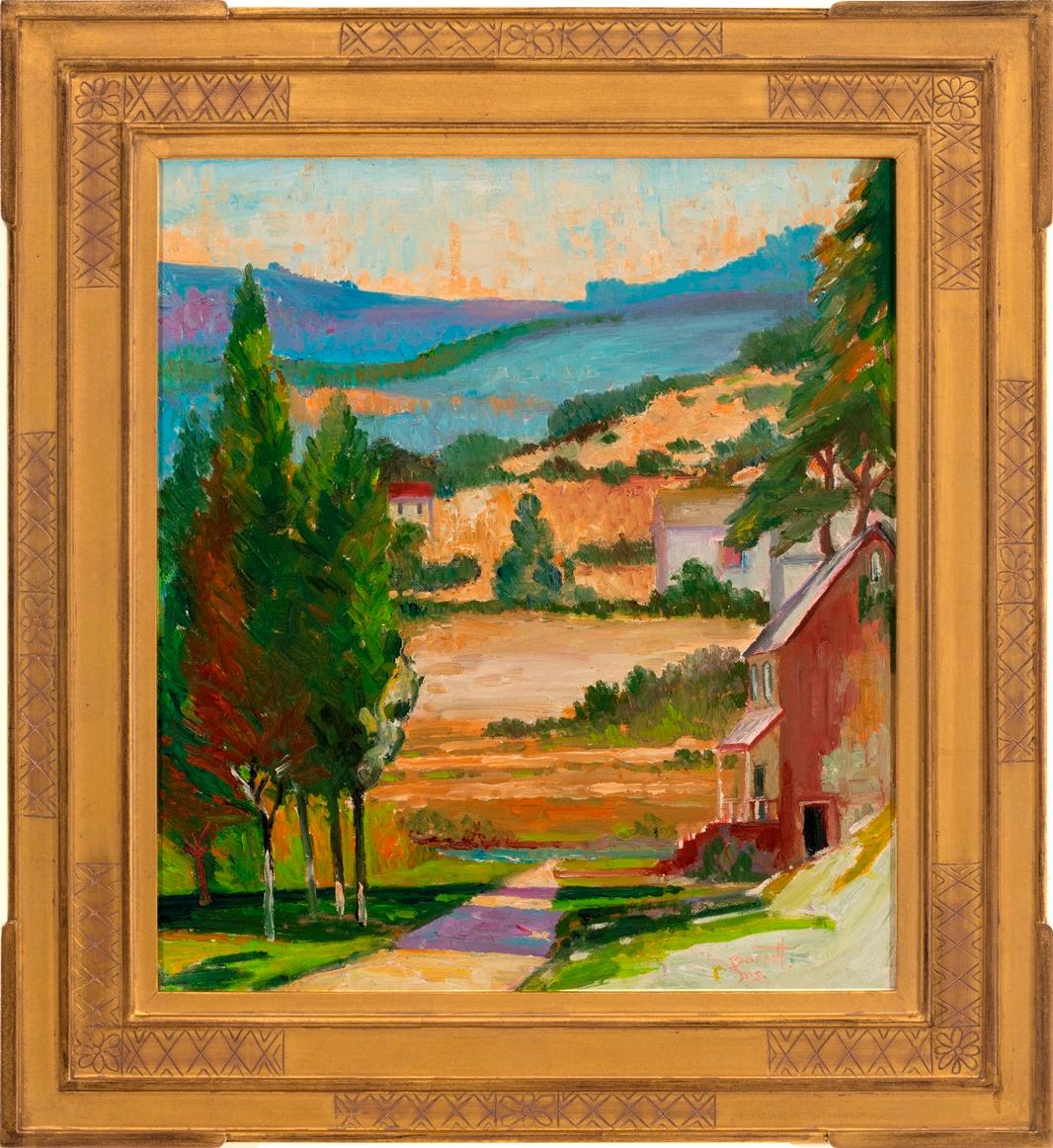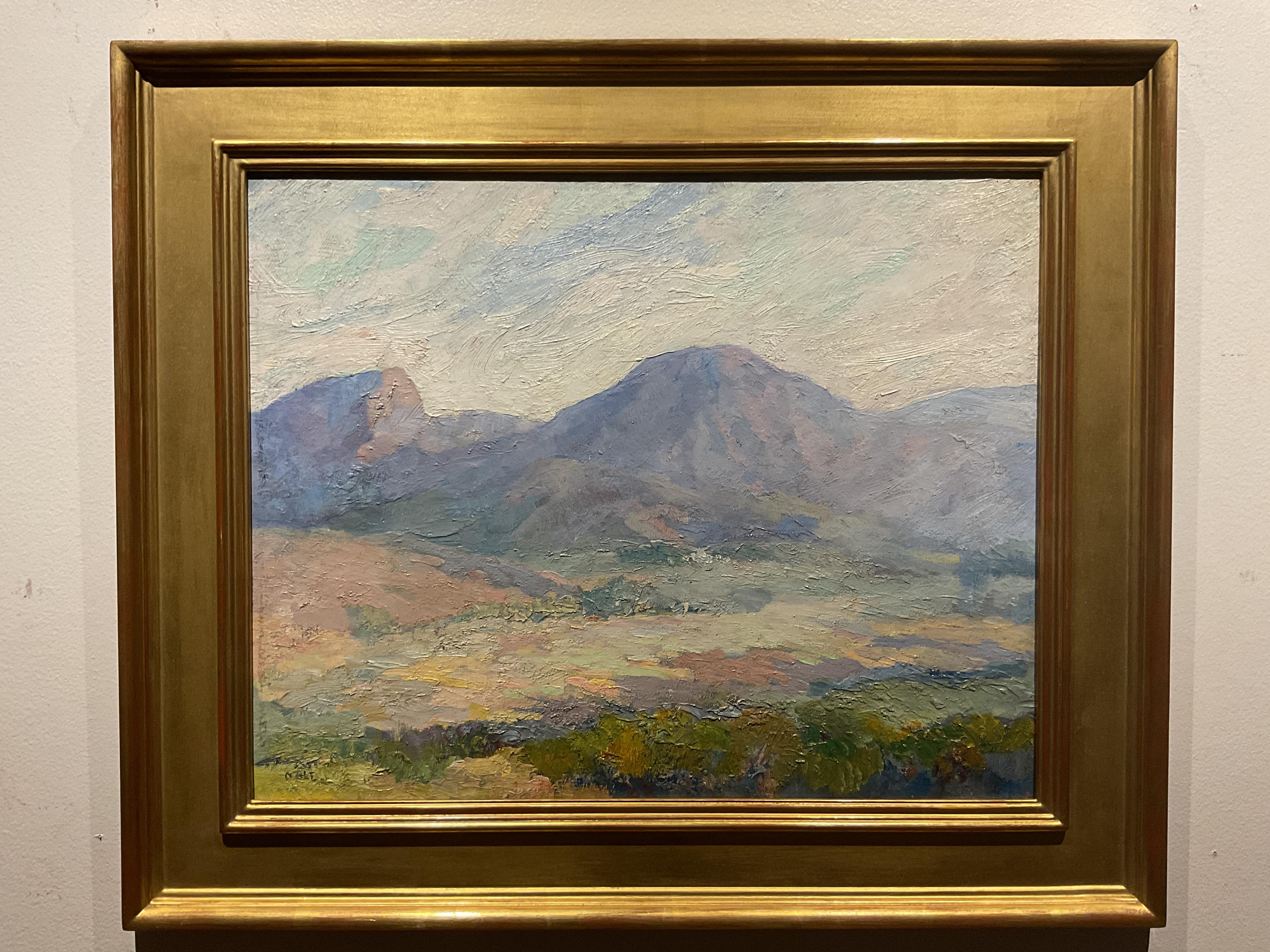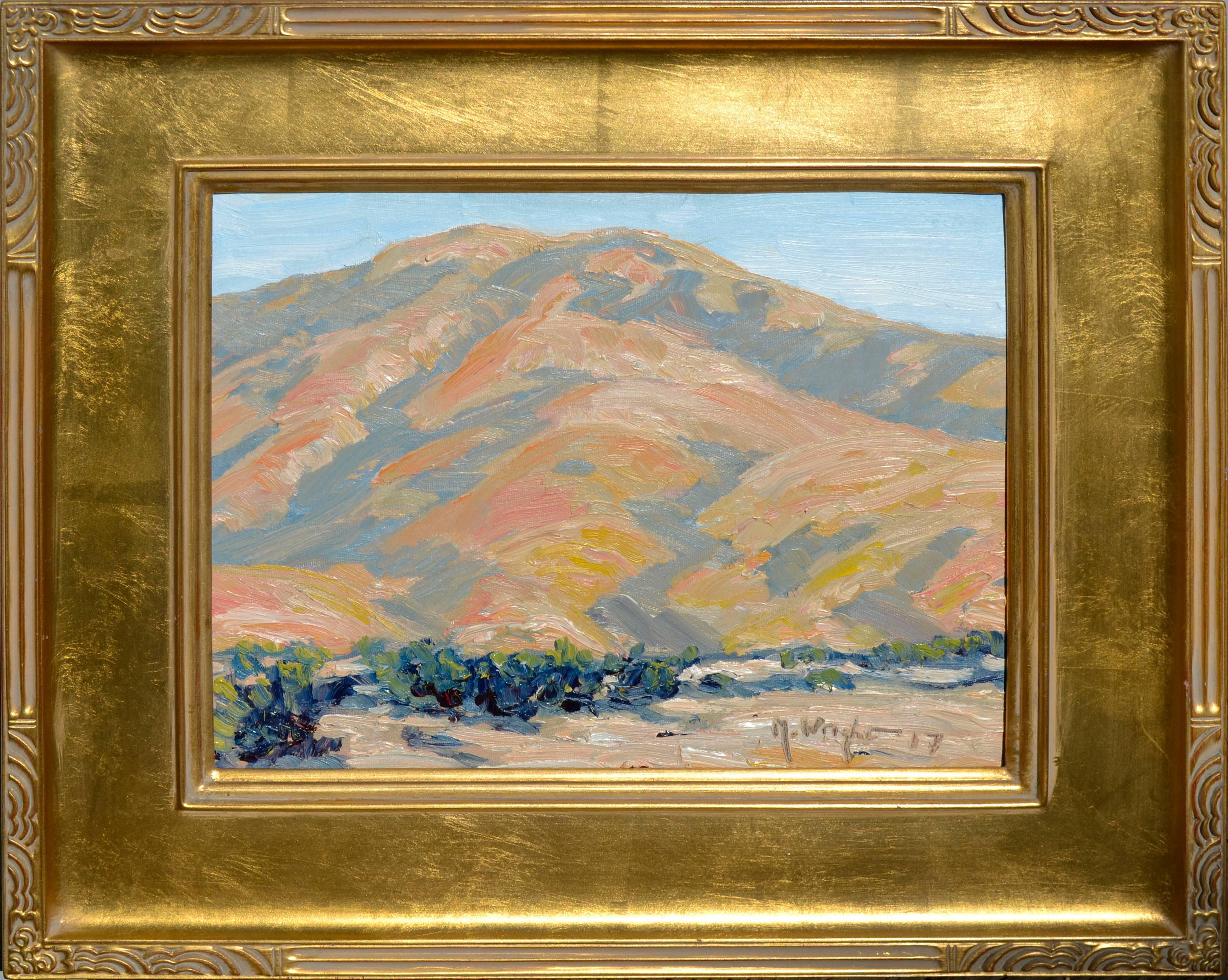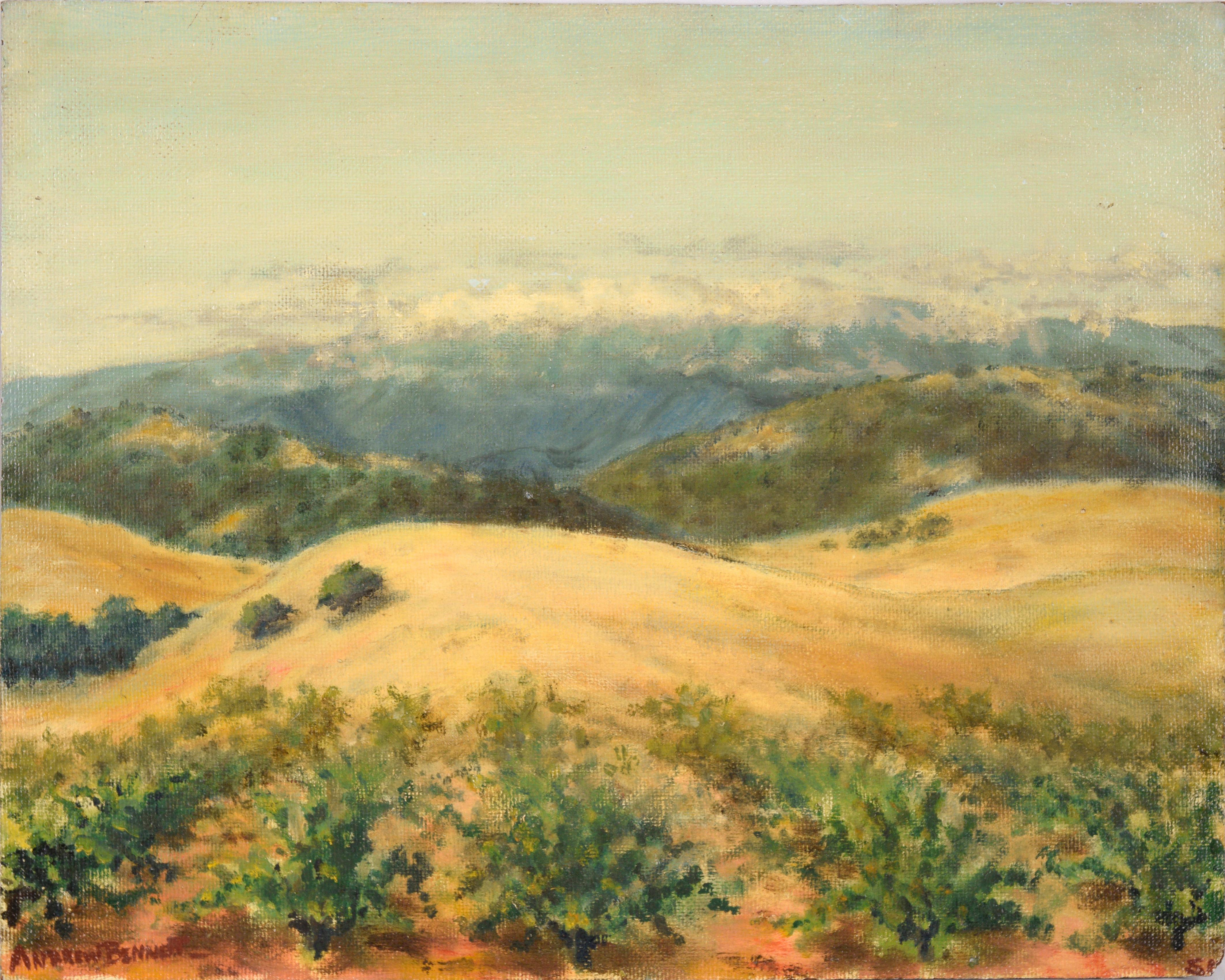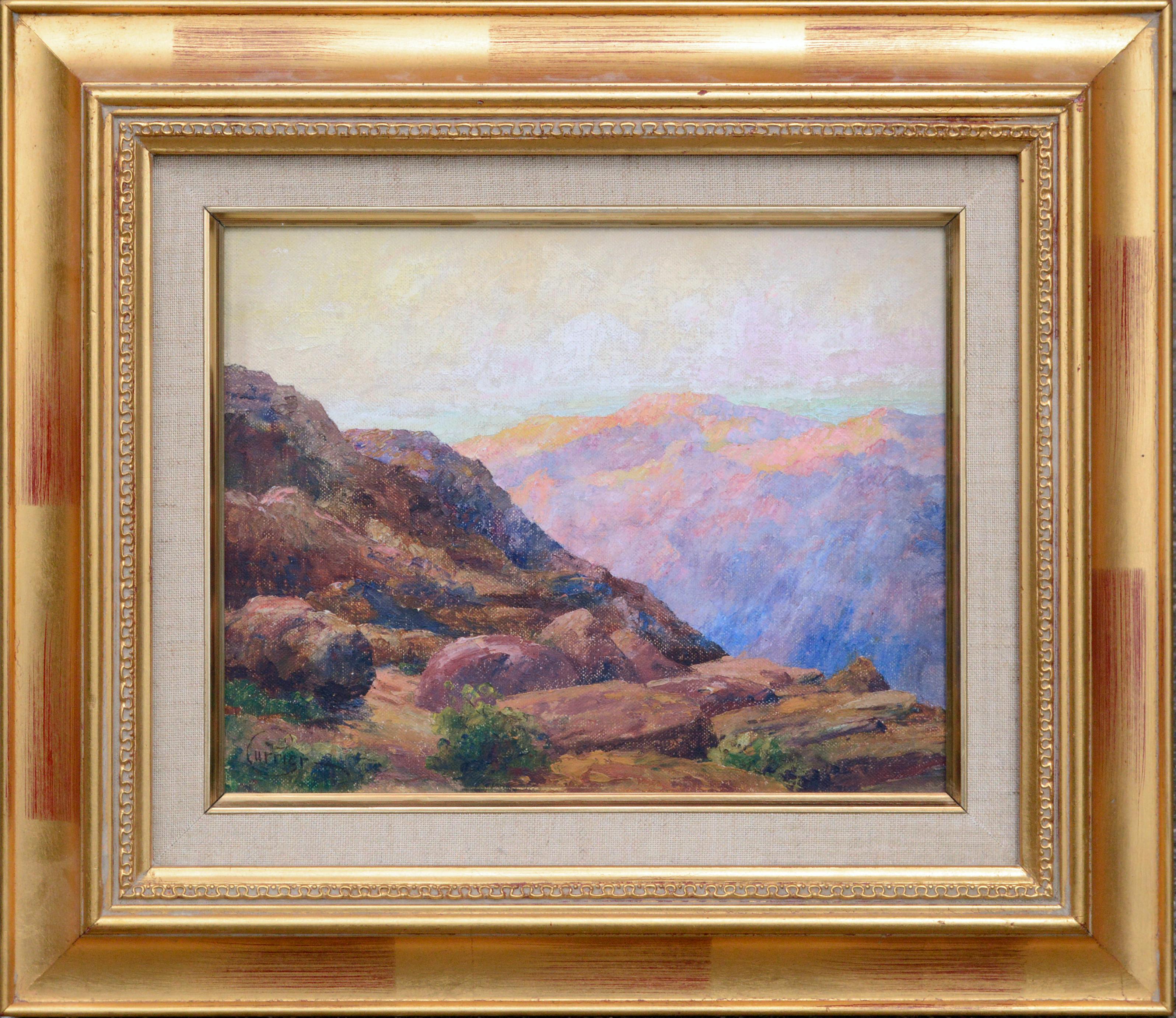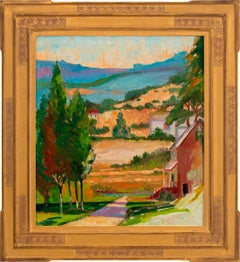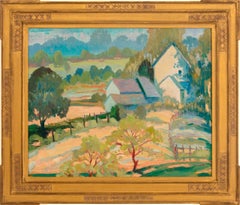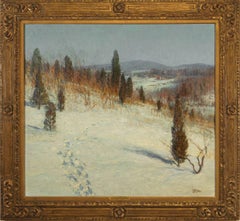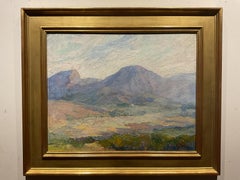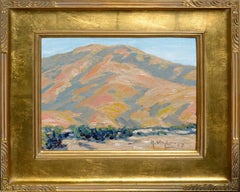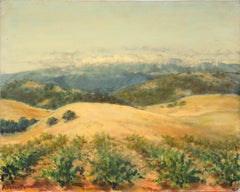Items Similar to "Hills of Carmel"
Want more images or videos?
Request additional images or videos from the seller
1 of 5
George William Sotter"Hills of Carmel"circa 1940
circa 1940
$74,375
£56,774.89
€65,266.56
CA$104,658.92
A$116,385.06
CHF 61,127.95
MX$1,422,924.16
NOK 761,712.91
SEK 718,089.54
DKK 487,099.46
About the Item
Jim’s of Lambertville is proud to offer this artwork.
Signed Lower Right
George W. Sotter (1879-1953)
George W. Sotter is remembered for painting the scenic towns, farms, mills and valleys that make Bucks County such a welcoming destination. Great artists leave behind in their art, a legacy. The early twentieth century was filled with talented artists, although, there is only ever a mere few, who can deservingly be regarded as “the best of.” Amid the vast field of American Impressionist painters, when painting a “nocturne,” George Sotter had no equal. He had the ability to make dark seem light. Most criticisms of nocturne paintings are that they are too dark, seeming dreary and depressing, or hard to read. This is where Sotter shines. He had the ability to turn a cold winter night into a glowing moonlit masterpiece. The moonlight lights up the snow and reflects off the water. Stars shine from above. Lighted Candles glow in the windows. These pictures are warm and soothing. Another of Sotter’s specialties was his amazing ability to paint clouds. He would fill half of his composition with billowing illuminist clouds and below would be an entire village painted with incredible detail demonstrating a masterful sense of light.
Sotter was a stained glass artist before he turned to landscape painting, and his stained glass work grew in importance during his life in Bucks County. Sotter discovered Bucks County in 1902. He was given a leave of absence from his job at a Pittsburgh stained glass studio to enroll at the Pennsylvania Academy. His employer, Horace Rudy had earlier attended the Academy and was friends with many important artists, one of whom being Edward Redfield. Rudy had arranged an introduction and the younger Sotter persuaded Redfield to give him instruction. This was a rare occurrence as Redfield did not fancy himself a teacher. A lifelong friendship resulted. Sotter returned to the Pittsburgh studio after the summer and fall with Redfield. He again studied at the Pennsylvania Academy from 1905-1907 with Thomas Anshutz, William Merritt Chase and Henry Keller. In1907, he married Alice Bennett, an artist who started working in the Rudy studio in 1904. In 1910, Sotter became an instructor at the Carnegie Institute of Technology's School of Fine Arts, a position he held until1919.
Sotter returned to Bucks County in 1919, fulfilling a vow he reportedly made to Redfield. His friend helped him find the house on Ash Mill Road, in Holicong, where the Sotters lived and operated the Sotter Studio. Although he considered himself a landscape painter at the time, his work with stained glass preceded him. He was consulted, and then began taking commissions for stained glass. His work in the medium quickly spread to Cleveland, Boston, and New York. Sotter had fifteen craftsmen working with him at one time and his work helped establish Bucks County as a center of stained glass art.
Sotter's work is in permanent collections of the James A. Michener Art Museum, LaSalle University Art Museum, New Jersey State Museum, Pennsylvania State Museum, Reading Public Museum, and the Woodmere Art Museum. He exhibited extensively throughout his career at most of Americas Prestigious institutions and won many awards, including the Silver Medal at the Panama-Pacific Exposition in San Francisco in1915.George Sotter died in Holicong, Bucks County, Pennsylvania in1953 at the age of seventy four.
Sources: New Hope for American Art by James M. Alterman
- Creator:George William Sotter (1879-1953, American)
- Creation Year:circa 1940
- Dimensions:Height: 28 in (71.12 cm)Width: 26 in (66.04 cm)Depth: 2 in (5.08 cm)
- More Editions & Sizes:Frame Size 26.5" x 30.5" x 2"Price: $74,375
- Medium:
- Movement & Style:
- Period:
- Condition:
- Gallery Location:Lambertville, NJ
- Reference Number:Seller: NJOL2051stDibs: LU3741446183
About the Seller
5.0
Vetted Professional Seller
Every seller passes strict standards for authenticity and reliability
Established in 1997
1stDibs seller since 2014
38 sales on 1stDibs
Typical response time: 22 hours
- ShippingRetrieving quote...Shipping from: Lambertville, NJ
- Return Policy
Authenticity Guarantee
In the unlikely event there’s an issue with an item’s authenticity, contact us within 1 year for a full refund. DetailsMoney-Back Guarantee
If your item is not as described, is damaged in transit, or does not arrive, contact us within 7 days for a full refund. Details24-Hour Cancellation
You have a 24-hour grace period in which to reconsider your purchase, with no questions asked.Vetted Professional Sellers
Our world-class sellers must adhere to strict standards for service and quality, maintaining the integrity of our listings.Price-Match Guarantee
If you find that a seller listed the same item for a lower price elsewhere, we’ll match it.Trusted Global Delivery
Our best-in-class carrier network provides specialized shipping options worldwide, including custom delivery.More From This Seller
View All"Hills Beyond New Hope"
By Joseph Barrett
Located in Lambertville, NJ
Illustrated in "Joseph Barrett, The Prime Years 1970s - 1990s", pg. 22, Plate #025
Jim’s of Lambertville is proud to offer this artwork by:
Joseph Barrett (1936 – )
Joseph Ba...
Category
Late 20th Century American Impressionist Landscape Paintings
Materials
Canvas, Oil
"Forest Grove Farm"
By Joseph Barrett
Located in Lambertville, NJ
Illustrated in "Joseph Barrett, The Prime Years 1970s - 1990s", pg. 40, plate #046.
Jim’s of Lambertville is proud to offer this artwork by:
Joseph Barrett (1936 – )
Joseph Barrett was born in Midland, North Carolina, in 1936 and studied at the Massachusetts College of Art in Boston and at the Tyler School of Art in Philadelphia. Barrett, now of Lahaska, Pennsylvania, has been painting his entire adult life. His favorite subjects include the landscape surrounding New Hope and many local landmarks often encompassing figures into his compositions. Barrett utilizes a heavy impasto and his palette bears similarities to that of Fern Coppedge and George Sotter. Barrett’s paintings are always found in unique and somewhat charming handmade frames designed by the artist and finished in metal leaf.
A living contemporary of the no longer living “New Hope School” impressionist painters, Joseph Barrett resides outside of New Hope above his old-fashioned antique shop and studio. Entering Barrett’s shop is like taking a step back in time. Inside this cluttered and dusty haven of treasures from the past, is a studio spanning only four by eight feet. This little studio, containing cans of old brushes and hundreds of used paint tubes...
Category
Late 20th Century American Impressionist Landscape Paintings
Materials
Canvas, Oil
"Floating Clouds"
By Charles Warren Eaton
Located in Lambertville, NJ
Jim’s of Lambertville is proud to offer this artwork by:
Charles Warren Eaton (1857 – 1937)
A longtime resident of Bloomfield, New Jersey, Charles Warren Eaton was widely known in ...
Category
20th Century American Impressionist Landscape Paintings
Materials
Oil, Board
"Cedar Hill"
By George William Sotter
Located in Lambertville, NJ
Jim’s of Lambertville is proud to offer this artwork.
Signed lower right.
Original Period Newcomb Macklin Frame
George William Sotter (1879 - 1953)
Born in Pittsburgh on September 25, 1879, Sotter began his art education with local teachers and with Henry G. Keller, who had studied in various German academies. Keller, known for his superb, atmospheric watercolors, taught at the Cleveland School of Art but Sotter studied with him in Pittsburgh. Later Sotter would exhibit between 1903 and 1937 at the Pennsylvania Academy of the Fine Arts. His works were also shown at the Corcoran Gallery (1912-23), the Carnegie International (1901-26), the National Academy of Design (1913 and 1921), and at the Art Institute of Chicago (1911-27). In 1915, Sotter exhibited four works at the Panama-Pacific International Exposition in San Francisco, where he won a silver medal. Sotter was known mainly as a stained-glass artist; his work may be seen from New York City to Salt Lake City. Around a dozen craftsmen worked under him for these commissions.
Sotter spent the summer of 1902 with Pennsylvania impressionist Edward Redfield in Boothbay Harbor, Maine. Between 1910 and 1919, Sotter taught at the Carnegie Institute of Technology. His paintings often feature large areas of sky filled with clouds and he frequently painted winter night scenes, such as Moonlight, Bucks County (Beacon Hill Fine Art), a perfectly successful depiction of a quiet, moonlit landscape filled with twinkling stars. Star-studded skies, although rare in landscape painting, go back at least to 1600 when they appear in the oeuvre of Adam Elsheimer...
Category
20th Century Abstract Impressionist Paintings
Materials
Canvas, Oil
"Up the Valley"
By Daniel Garber
Located in Lambertville, NJ
In an original Harer frame.
Illustrated in "Daniel Garber Catalogue Raisonne" Vol. II, pg. 271, and in book titled "Blue Chips", pg. 33
Jim’s of Lambertville is proud to offer this artwork by:
Daniel Garber (1880-1958)
One of the two most important and, so far, the most valuable of the New Hope School Painters, Daniel Garber was born on April 11, 1880, in North Manchester, Indiana. At the age of seventeen, he studied at the Art Academy of Cincinnati with Vincent Nowottny. Moving to Philadelphia in 1899, he first attended classes at the "Darby School," near Fort Washington; a summer school run by Academy instructors Anshutz and Breckenridge. Later that year, he enrolled at the Pennsylvania Academy of the Fine Arts. His instructors at the Academy included Thomas Anshutz, William Merritt Chase and Cecilia Beaux. There Garber met fellow artist Mary Franklin while she was posing as a model for the portrait class of Hugh Breckenridge. After a two year courtship, Garber married Mary Franklin on June 21, 1901.
In May 1905, Garber was awarded the William Emlen Cresson Scholarship from the Pennsylvania Academy, which enabled him to spend two years for independent studies in England, Italy and France. He painted frequently while in Europe, creating a powerful body of colorful impressionist landscapes depicting various rural villages and farms scenes; exhibiting several of these works in the Paris Salon.
Upon his return, Garber began to teach Life and Antique Drawing classes at the Philadelphia School of Design for Women in 1907. In the summer of that same year, Garber and family settled in Lumbertville, Pennsylvania, a small town just north of New Hope. Their new home would come to be known as the "Cuttalossa," named after the creek which occupied part of the land. The family would divide the year, living six months in Philadelphia at the Green Street townhouse while he taught, and the rest of the time in Lambertville. Soon Garber’s career would take off as he began to receive a multitude of prestigious awards for his masterful Pennsylvania landscapes. During the fall of 1909, he was offered a position to teach at the Pennsylvania Academy as an assistant to Thomas Anshutz. Garber became an important instructor at the Academy, where he taught for forty-one years.
Daniel Garber painted masterful landscapes depicting the Pennsylvania and New Jersey countryside surrounding New Hope. Unlike his contemporary, Edward Redfield, Garber painted with a delicate technique using a thin application of paint. His paintings are filled with color and light projecting a feeling of endless depth. Although Like Redfield, Garber painted large exhibition size canvases with the intent of winning medals, and was extremely successful doing so, he was also very adept at painting small gem like paintings. He was also a fine draftsman creating a relatively large body of works on paper, mostly in charcoal, and a rare few works in pastel. Another of Garber’s many talents was etching. He created a series of approximately fifty different scenes, most of which are run in editions of fifty or less etchings per plate.
Throughout his distinguished career, Daniel Garber was awarded some of the highest honors bestowed upon an American artist. Some of his accolades include the First Hallgarten Prize from the National Academy in 1909, the Bronze Medal at the International Exposition in Buenos Aires in 1910, the Walter Lippincott Prize from the Pennsylvania Academy and the Potter Gold Medal at the Art Institute of Chicago in 1911, the Second Clark Prize and the Silver Medal from the Corcoran Gallery of Art for “Wilderness” in 1912, the Gold Medal from the Panama-Pacific Exposition in San Francisco of 1915, the Second Altman Prize in1915, the Shaw prize in 1916, the First Altman Prize in 1917, the Edward Stotesbury Prize in1918, the Temple Gold Medal, in 1919, the First William A...
Category
1940s American Impressionist Landscape Paintings
Materials
Oil, Panel
"Rushland"
By Joseph Barrett
Located in Lambertville, NJ
Illustrated in "Joseph Barrett, The Prime Years 1970s - 1990s", pg. 17, Plate #020
Jim’s of Lambertville is proud to offer this artwork by:
Joseph Barrett (1936 – )
Joseph Ba...
Category
Late 20th Century American Impressionist Landscape Paintings
Materials
Canvas, Oil
$16,875
You May Also Like
Lovely California Landscape Painting by listed artist John Thomas Nolf, ca 1920s
Located in Baltimore, MD
John Thomas Nolf was born in Allentown, Pa. in 1872. He had his academic studies in Chicago at the Art Institute. He exhibited often at the Institute,...
Category
Early 20th Century American Impressionist Landscape Paintings
Materials
Oil
South of San Luis Obispo, California Landscape
By Mike Wright
Located in Soquel, CA
A beautiful, heavy impasto landscape of a scene south of San Luis Obispo, California by Mike Wright (American, b.1959). Signed "M. Wright 17" lower right c...
Category
2010s American Impressionist Landscape Paintings
Materials
Canvas, Oil, Cardboard
$1,160 Sale Price
20% Off
The Hill
By Charles Herbert Woodbury
Located in Milford, NH
A pleasant impressionist landscape by well known American artist Charles Herbert Woodbury (1864-1940). Woodbury was born in Lynn, MA, and sold his first painting when he was fifteen ...
Category
1910s American Impressionist Landscape Paintings
Materials
Oil, Board
"California Round Hills" Mid Century Plein Aire Landscape in Oil on Masonite
Located in Soquel, CA
"California Round Hills" Mid Century Plein Aire Landscape in Oil on Masonite
Serene landscape by J. Andrew Bennett (British, 19th/20th Century ). The viewer stands at the end of a v...
Category
1950s Impressionist Landscape Paintings
Materials
Masonite, Oil
Early 20th Century Distant Canyon Landscape
By Cyrus Bates Currier
Located in Soquel, CA
Gorgeous, accomplished western canyon landscape with distinct foreground and background coloration by Cyrus Bates Currier (American, 1868-1946). Signe...
Category
1920s American Impressionist Landscape Paintings
Materials
Canvas, Oil, Cardboard
$1,397 Sale Price
35% Off
Fall Mountain
By Emile Albert Gruppe
Located in Milford, NH
A fine impressionist New England Fall mountain landscape with changing foliage by American artist Emile Albert Gruppé (1896-1978). Gruppé was born in Rochester, NY, and is renowned ...
Category
Mid-20th Century American Impressionist Landscape Paintings
Materials
Canvas, Oil
More Ways To Browse
George Read Art
Edward Hill
Thomas Hill
Bucks County Art
Bucks County Painting
Bucks County Pennsylvania
Moonlit Landscape
Bucks County Oil
Thomas Hill Oil Painting
Bucks County Impressionists
Carmel Valley Painting
Carmel Silver
James Michener
Thomas Anshutz
Vintage Glow In The Dark Glass
Half Frame Reading Glasses
Landscape Lavender Impressionist
Mosaic Scene
